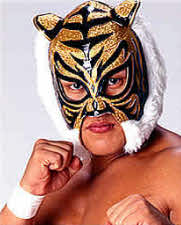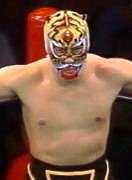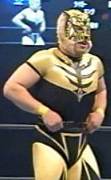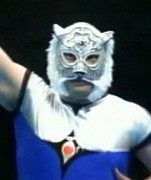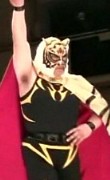
|
||||||||||
|---|---|---|---|---|---|---|---|---|---|---|
|
Satoru Sayama
Birthdate: November 24th, 1957 Reviews: Pictures: The Evolution of Tiger Mask:
Featured Signature Moves: Other Signature Moves: Signature Moves (as Tiger Mask, circa 1981 to 1983): Signature Moves (as Super Tiger, circa 1984 to 1985): Career History: Few wrestlers in professional wrestling history have had such an impact on the sport as Satoru Sayama. Debuting in 1976, for the first fives years of his career Sayama saw little success as he began mastering a style that had never been seen in Japan before. In 1981 he became Tiger Mask, and for the next two years he memorized fans around the globe with his aerial skills. In 1983 he grew tied of professional wrestling, and for the next few years he participated in "shoot-style" and became a trainer. After working mostly as a trainer for a decade, Sayama made a surprising return to professional wrestling in 1994, first wrestling Jushin Thunder Liger and later wrestling (and teaming with) Antonio Inoki. After wrestling in various promotions as a freelancer for years, in 2005 he started Real Japan Professional Wrestling. As a promoter and main eventer, Sayama is larger and not as fast he was in his prime but he still can awe the crowd with his skill and agility. After training in high school under amateur wrestling and Judo, in 1976 Sayama joined New Japan Professional Wrestling. He had his debut match against Shoji Kai on May 28th, 1976. Weighing only 160 pounds, Sayama did not have the look of a traditional wrestler but due in part to his past Judo experience he showed a good amount of skill that excited the crowd. After wrestling in England as Sammy Lee (where he first met his future foe Dynamite Kid), New Japan worked out a deal with Ikki Kajiwara to bring a Tiger Mask character into New Japan. Tiger Mask was a popular anime series in Japan, with the main character wearing a tiger mask with blue pants and a red cape. On April 23rd, 1981, Sayama put on the Tiger Mask outfit for the first time against Dynamite Kid and almost immediately won the crowd over as Tiger Mask even though they knew who was wrestling under the costume. While the gimmick might have been a career killer for some wrestlers (it was initially thought to be silly as it wasn't traditional in Japan at the time to have cartoon characters as wrestlers), it made Sayama an international superstar. Performing moves that no one had ever seen before, Tiger Mask brought a new style that mixed submission holds and aerial moves to excite fans from around the globe. On January 1st, 1982, Tiger Mask would win his first major title in Japan as he defeated Dynamite Kid for the WWF Jr. Heavyweight Championship. Five months later he would lose the title to Black Tiger, but on May 26th he would win the title right back with the Rounding Body Press. After holding the title for almost a year, in April of 1983 he would be forced to vacate the title due to a knee injury. The injury didn't keep him out long, however, as on June 13th, 1983 he would win the title back by defeating Gran Hamada. Tiger Mask seemed poised to lead the new Jr. Heavyweight Division for years to come, as more wrestlers (such as Black Tiger, The Cobra, and Dynamite Kid) embraced the style Tiger Mask had perfected. Unfortunately it was not to be, as on August 12th, 1983 Sayama shocked the wrestling world when he retired. He had grown tired of "fake" wrestling, and even wrote a book (called Kayfabe) where he talked about how wrestling really worked and why he was leaving it. In 1984 he joined UWF, wrestling under his real name, The Tiger, and Super Tiger. UWF was a "shoot-style" promotion, meaning that the style was more strike and submission based with the appearance of being a more realistic fight. After feuding with Akira Maeda both in and out of the ring, in 1985 it all came to a head. In a match against each other, Maeda kicked Sayama hard in the groin, flooring the former Tiger Mask and earning him a DQ. This led to Sayama leaving UWF, not only due to his trouble with Maeda but also because backstage he was considered selfish and a poor leader. On his own again but still young, Sayama continued searching to regain the success he had found just a few years earlier. In 1986, Sayama started Shooto, a promotion which more resembled a mixed martial arts competition as the results were not pre-determined. Sayama finally found his place as a trainer, and he helped develop many future stars of Shooto and MMA. After focusing on MMA for almost a decade, Sayama surprised the wrestling world once again when he returned in 1994 to professional wrestling. After battling Jushin Thunder Liger to a draw in New Japan on May 1st, 1994, Sayama (wrestling as Tiger King) participated in a number of smaller promotions. He even won the TWA Tag Team Championship with Anjo while wrestling in Tokyo Pro, his first wrestling title in over 12 years. In 1996 and 1997 he again went back to New Japan, and he wrestled Antonio Inoki on April 12th, 1997 as part of Inoki's retirement countdown. After wrestling in various indys for several years (including matches against the former Tiger Mask III (Kanemoto) and Tiger Mask IV), Sayama joined Inoki's Universal Fighting Arts Organization in 1998. The UFO had limited success however, and in 1999 Sayama opened Seikendo. Seikendo never took off as a promotion (Sayama did continue training however), and as the new century began Sayama still was struggling to find the success that he had found earlier in his career. On April 16th, 2005 he started a new promotion called Real Japan Pro Wrestling. Mixing cards with both professional wrestling and Karate, Sayama (as Super Tiger) combined his two loves onto one event. Being the main attraction of the promotion, Sayama wrestled Shinjiro Otani, Tatsuhito Takaiwa, Yuki Ishikawa, Naomichi Marufuji (with Sayama winning), Minoru Suzuki, and many others. He also begun training new professional wrestlers, with Tiger Shark and Super Tiger II being his top two trainees. Playing the role of both wrestler and trainer, Sayama enjoys the twilight of his career running his own promotion and wrestling occasionally in other smaller promotions. From his debut in 1976 to his current work in Real Japan, Sayama has had one of the most fascinating careers of any wrestler in Japan. His work as Tiger Mask helped popularize the Jr. Heavyweight style and inspired countless of other wrestlers. His separation from professional wrestling after only two years was shocking, as was his burial of the sport that had put him on the map. As a wrestler in UWF he was still great in the ring but his backstage attitude led to his quick exile. But with Shooto he created at the time one of the more successful training grounds for MMA and he proved that he was able to train new fighters successfully. To tie it all together, now he runs his own promotion that is involved in both, and Real Japan is the first promotion to have Karate and professional wrestling on the same card. A true living legend, Sayama revolutionized the Jr. Heavyweight Division and is one of the most well-known and controversial figures in wrestling history. |
||||||||||
|
